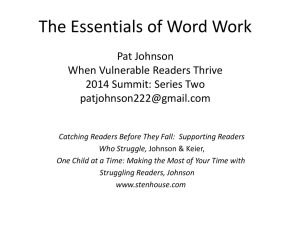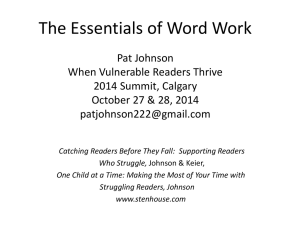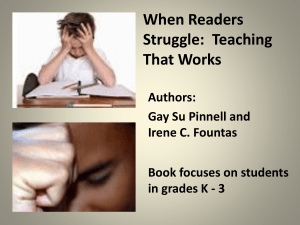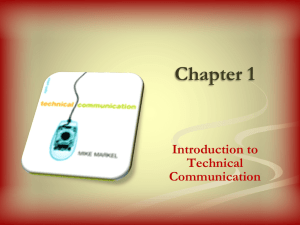Handouts_files/Seattle summit wordwk handout
advertisement
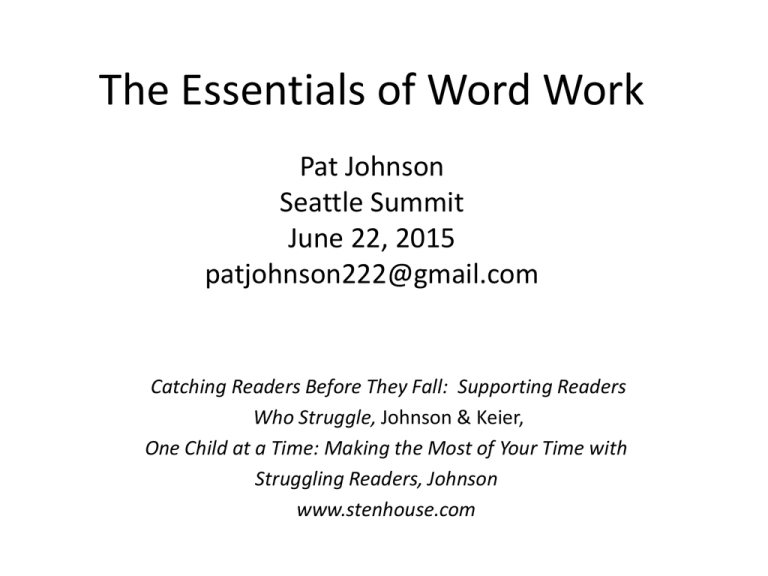
The Essentials of Word Work Pat Johnson Seattle Summit June 22, 2015 patjohnson222@gmail.com Catching Readers Before They Fall: Supporting Readers Who Struggle, Johnson & Keier, One Child at a Time: Making the Most of Your Time with Struggling Readers, Johnson www.stenhouse.com Demonstrate and teach word solving principles with whole group or small group lessons. Provide opportunity for students to apply the principles – hands on work with words in applicable activities. Teach for, prompt for, and reinforce problem solving while readers are processing continuous text. When Readers Struggle, p. 242 “Remember, word solving is about learning how to connect words in ways that generate more word knowledge. Word learning will be useless unless children can use the information while writing and reading.” Fountas & Pinnell Word Matters, p. 99 Children need to use a balance of their sources of information when solving words on continuous texts. Sources of Information: woods forest Meaning Word Solving Syntactic look looks book took Visual f in d find An ELL child might place a lot of weight on visual analysis. “Another child who has strong oral language skills … may try to avoid the tedium of the careful analysis of print in reading and attention to detail in writing. And their avoidance behavior requires astute detection.” Marie Clay Literacy Lessons 2, p. 168 Also be aware of: Child who looks up and away rather than trying to solve. Child who has a “learned confusion” and thinks there are 2 alternatives and that either response will do. You must help him learn what is OK and what is not OK. Child who did pretty well sounding letter by letter, but never moved onto chunks. It isn’t always about accuracy – sometimes it’s about taking on a part of a word solving strategy or strategic behavior. “Struggling readers tend to appeal rather than work actively at words.” Fountas & Pinnell When Readers Struggle p. 261 “…the teacher’s job is not delivering knowledge, but arranging for the problem to be manageable, sustaining the child’s problem-solving attempts emphasizing flexibility.” Peter Johnston “Revolutionary Contributions” The Journal of RR, Fall, 2007 Students need to be flexible when word solving. “We do not want the brain to specialize in learning one response for each symbol. Why? Because English is not like that. It is more important that the beginning reader adopt a different stance: ‘It might be this, or it could be that.’ ” Marie Clay Literacy Lessons 2, p. 123 What would happen if children are inflexible and think that ‘a’ either says short a or long a: am again stain mall hard bean saw caught animal anyway said “…children should be flexible enough to try something else when their first trial is unsuccessful, and that they need a growing repertoire of what the most likely possibilities may be.” Billie Askew Voices on Word Matters, p. 149 Teachers need to be thinking about the concepts of how words work 14 Principles of how words work: 1. Initial letters can be changed. go/so look/book make/take 2. Final letters can be changed. cat/can bed/bet hot/hop beat/bean 3. Letters can be added to the ends of words. look/looks play/playing stay/stayed the/them teach/teacher you/your 4. Words can be put together. in + to = into dog + house = doghouse 5. Initial letters can be upper or lower case. the/The Here/here is/Is Principles of how words work: 6. . Middle letters can be changed. dad/did sat/sit got/get ripe/rope 7. Letter clusters at the beginnings of words can be added or changed. play/stay sing/thing stamp/champ 8. Letter clusters at the ends of words can be changed. will/with must/much back/band 9. Letter clusters in the middle can be changed. sheet/shirt pail/peel chirp/champ Principles of how words work: 10. Letters can be added to the front of words or word parts. am/ham or/for up/cup it/spit 11. Some words sound the same but are spelled differently. here/hear to/two/too 12. Some words are spelled the same but sound different. read/read record/record Principles of how words work: 13. Words can be read through analogy. stump st op j ump crack cry back trail tr ee m ail 14. Letters can be added at the beginning and at the ending of words or letter chunks. at splat splatter stand understand understanding eat tr eat tr eat ing am champ champion ar art smart smartest Child makes analogies on his own: “Before the teacher can allow the child to think of another word and then make the change himself, he must be working with considerable independence. She has to prepare the ground carefully for that independence.” Marie Clay LL2, p. 144 Learning how words work could be done entirely on the words the child already knows. Do not hurry into new territory. Most supportive level: Notice the different concepts: book can up look cat cup Teacher gives both words and does so both orally and visually. Slightly less support from teacher: go has _and shirt Teacher gives the two words orally, but only one is visual. Much less support: look play must _or Teacher asks the question. Child must initiate the word. car_ Least amount of support: • When reading continuous text, the child must make the analogy. st am p “The habit of linking needs to start early.” Lee Skandalaris We want kids to say, “this is like that.” • • • • • “I have that word in my other book” ‘brother’ – that’s like Brian’s name This story is like that other book Hey, ‘shoe/too’ – they rhyme That has ‘and’ in it --- standing There are different levels of knowing a word. We cannot assume that a correctly read word is known in all its detail.” Clay, LL2, p. 46 When does a child really know a word? • • • • • • New word Only just known Successfully problem-solved Easily produced but easily thrown Well-known and recognized in most contexts Known in many variant forms. Marie Clay Literacy Lesson Two, p. 46 Instruction on “word work” is woven throughout the day. “ … teachers must abandon the notion that they must first teach the child to remember words before that child will be able to read or write them. To the contrary, children will remember words because they have met them and worked on them many times.” Clay LL2, page 139 Word work opportunities throughout the day: • • • • • • • Mini-lessons for word study Morning Message Shared Writing/ Interactive Writing Centers/Stations Writing Workshop Shared Reading Before, during, after Guided Reading “Writing can contribute to the building of almost every kind of inner control of literacy learning that is needed by the successful reader.” Marie Clay Support ELLS with word solving through your book introductions. Procedures for a book introduction: Always give the title Give a short summary – the big idea Hook the children with a comment or question to encourage their talk While conversing, allow the children to predict and negotiate the meaning Use some of the vocabulary from the text Practice an awkward language structure if needed Include a ‘predict and locate’ word if necessary Mention, model, or remind children of the teaching focus Save some things for the children to problem solve on their own • General Book Intro info in Catching Readers Before They Fall, pages 78-80 • Specific ways to support ELLS - Chapter 7 in One Child At A Time ELLs and Awkward Language Structures: Examples: Home we go. Off they went to the beach. Away went Lizard. Suggested Teaching Moves: Use it in the book intro conversation Tell the child it’s a different way to say it Have the student practice it Give an “in” and “out” of text example ELLs and Irregular Verbs or Advanced Verb Tenses Examples: The balloon blew away. The shell is broken. Nick swam across the pool. She would have gotten hurt badly if… Suggested teaching moves: Bring it to the child’s attention Provide in and out of text examples Let the child practice Give the child a way to solve the word Vocabulary • Known words used in a new way • Known concepts, but the English label is unknown • Unknown concept and unknown English label Vocabulary – Known words used in a new way Examples: I am pleased I let you go. Back in the village the people heard the boy’s cries. Suggested teaching moves: Tune in when comprehension is lost Support the student to use context clues to pick another word that would make sense here Elaborate on the meaning as used in the text Add an out-of-text example Vocabulary – Known concepts; unknown English labels Examples: Little mouse gnawed and gnawed and gnawed. “It stopped raining,” said Bill, peering out of the tent. Suggested teaching moves: • Help the child make connections to a concept that is known • Expand upon the meaning • Give the child a way to figure out the word Vocabulary – Unknown word and unknown concept Examples: 3-legged race hang-gliding hearth scarecrow Suggested teaching moves: Give a way to figure out the word so that the child can pronounce it correctly on his own Use pictures, drawings, or physical motions to elaborate on the meaning of the word So what about high frequency words? “Struggling readers… generally have a lower repertoire of words that they can recognize effortlessly and their word solving is inefficient, slow, and tedious.” Fountas & Pinnell When Readers Struggle, p. 261 “By the end of first grade, children should be able to write 50-100 words quickly and accurately and to use their knowledge of spelling patterns to produce many more words, which may be correct or nearly correct.” Fountas & Pinnell Word Matters, p. 89 Develop a way to study words: • Look at the word; use your eyes. (teacher can say it and run finger under it.) • Run your finger under it as you say it slowly (coordinating L-to-R) • Close your eyes and see it. • What do you hear at the beginning? (using ears.) • Look again (child scans without help.) • Now try writing it here (not copying.) • • • • • Arrange for repetition Arrange for over-learning Practice reconstructing with magnetics Introduce tracing Use games “Games in general have little value, but designed specifically for a particular child and used for a brief period of time they may help to increase the items that a child remembers.” LL2, Clay, p. 176 Other sources - Word Matters: • Chapter 14 – How to set up routines in your classroom for a word study system – choosing words, spelling buddies, activities with word learning, look/cover/say/check, buddy tests, etc. • Appendix 34 – lists of mini-lessons on word solving strategies, saying words slowly, using resources, giving a buddy test, etc. • In When Readers Struggle - Chapter 12, Building and Using a Repertoire of Words – activities for working with words. Catching Readers Before They Fall, Pat Johnson and Katie Keier, Stenhouse One Child at a Time: Making the Most of Your Time with Struggling Readers, Pat Johnson, Stenhouse patjohnson222@gmail.com (@PatJ222 on Twitter) katieannkeier@gmail.com (@bluskyz on Twitter) www.catchingreaders.com Follow our Catching Readers page on Facebook
